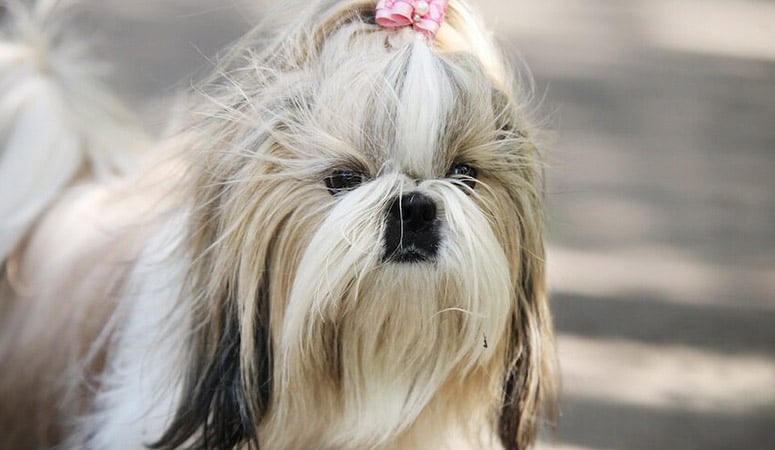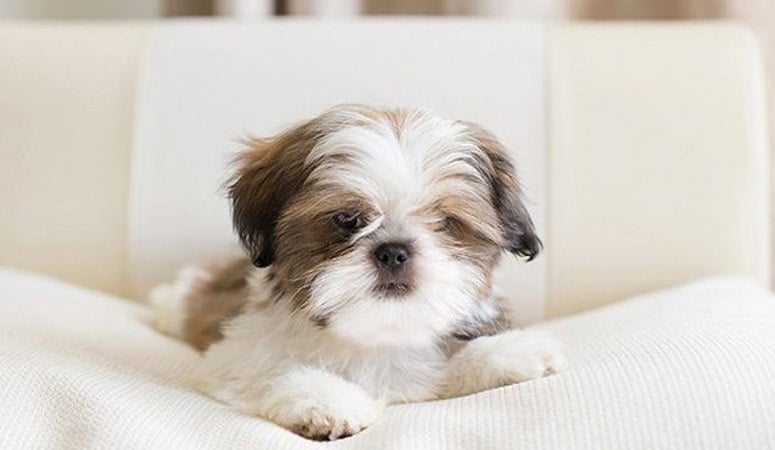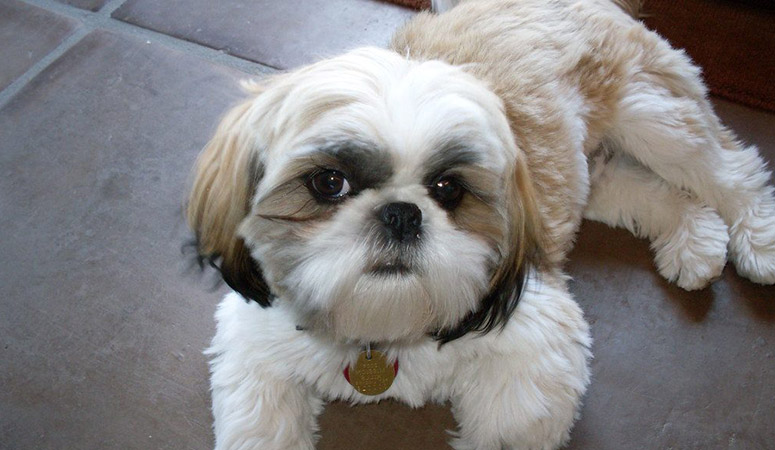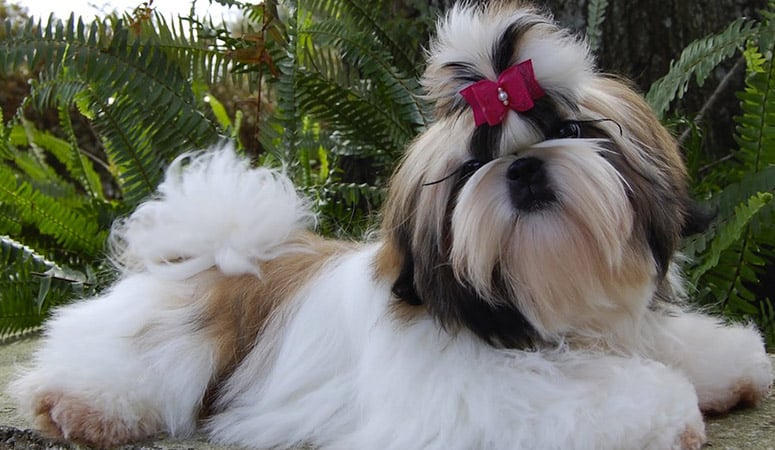Shih Tzu
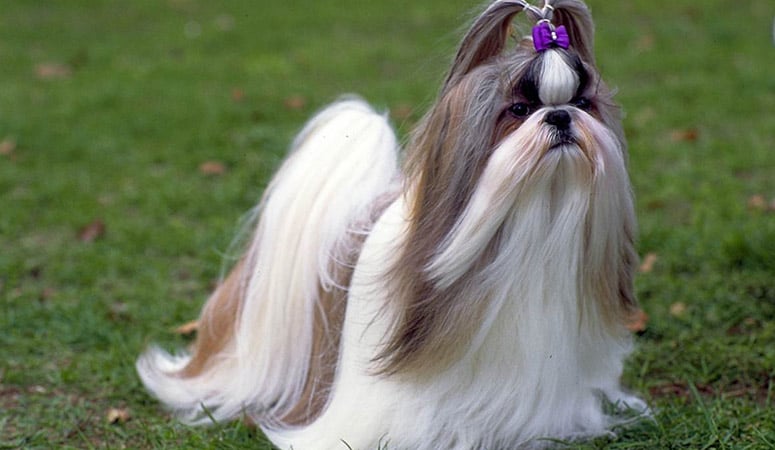
Developed in Tibet, the Shih Tzu was is one of the oldest dog breeds. He has a double long dense coat, and the hair is fairly straight. There is nothing fierce about this dog breed although the name “Shih Tzu” means little lion. The look of Shih Tzu is always warm, sweet, and loving, which expresses their friendliness and trust.
| Other Names | Chinese Lion Dog, Chrysanthemum Dog |
| Color | Variations include black, blue, brindle, gold, liver, red, and silver, and white bi-colored |
| Height | Males: 8-11 inches. Females: 8-11 inches. |
| Weight | Males: 9-18 pounds. Females: 9-18 pounds. |
| Life Span | 10-18 years |
| Personality | Affectionate, Playful, Outgoing |
| Exercise | Regular Exercise |
| Origin |
| Popularity | #20 |
| Groom Needs | Daily |
| Kids Friendly | Yes |
| Dog Friendly | Yes |
| Watch Dog | |
| Family Dog | |
| Litter Size | 2-9 |
Shih Tzu Pictures
Shih Tzu Video
Introduction
The Shih Tzu is a beautiful, little toy dog recognized by its fine, soft, and silky coat, seldom wavy, that comes in various shades of color. The coat color varies a lot with a black, gold, liver or white here and there. Shih Tzu usually has a long coat that tends to reach the ground, making it prone to getting entangled with dirt. But unlike other breeds, the Shih Tzu does not shed its fur easily, so bathing and brushing can be done more frequently. This dog is a beauty to behold when nicely groomed and well-fed.
A typical Shih Tzu would give up running around the backyard chasing rats for a more relaxing activity like accompanying you from room to room within the house. They are compact, and lively dogs weighing no more than 17 pounds and stand at roughly 9 or 10 inches high from paw to shoulder.
The small head is completed by a short muzzle and bold dark brown eyes that shine with allure, affection, and even mischief. Surprisingly, they often outlast the larger and seemingly sturdier dog breeds. A Shih Tzu lives up to 13-17 years on the average.
Living with Shih Tzu
The long coat of Shih Tzu needs daily brushing, the owner can use a good-quality wire brush with flexible pins, and layer the hair to be sure you reach to the skin. At about ten to twelve months of age, the Shih Tzu’s coat changes from puppy fluff to a silky adult coat. During this period, the owner may find that the dog’s coat mats faster. This could last about three months, brushing would get easier once the adult coat comes in fully.
Besides, the owner needs to comb your dog’s mustache and topknot daily, and gently clean the corner of the eyes with a damp cloth. And trimming the hair on the top of your dog’s head or tying it up to a topknot to prevent Shih Tzu’s eyes from being irritated.
To keep the dog’s coat clean and look its best, it is recommended to bathe it every three or four weeks. And check the ears weekly for dirt, redness, or a bad odor that may indicate an ear infection. Brush your dog’s teeth once a week or more frequently to prevent tartar buildup and gum disease. Additionally, nails should be trimmed once per month if the dog does not wear the toenails down naturally.
The Shih Tzus are bred to be house companions, they are lap dogs and not very active compared to the outdoorsy dog. Generally, a simple walk around the block and some romping time in the yard or at the park are enough to satisfy their daily exercise requirements – about 40 minutes total each day.
Shih Tzus are sensitive to heat same as their short muzzle dog breeds, on the hot days, they should stay indoors in an air-conditioned room so they don’t suffer from heat exhaustion. Besides, the young Shih Tzu puppies should not be given too much exercise as their joints and bones are still growing, it may cause a dog a few problems later on their life if their joints and bones suffer too much pressure.
Shih Tzus are prone to food allergies and they may need a special diet if they show symptoms of food allergies such as itching, chewing on feet, or digestive issues. Generally, it is recommended to feed a Shih Tzu with three quarters to one cup of high-quality dry dog food per day, divided into two meals. More importantly, the food amount should depend on the dog’s weight, age, activity level. And there should be fresh and clean water at all times.
Some dogs are easy to get overweight, so you need to watch their calorie consumption and weight level all the time. Treats may be an important aid in training, but excessive intake can lead to obesity. Also, owners need to distinguish which human food is safe for dogs and which are not. If you have any problems with your dog’s weight or diet, just consult from your veterinarian.
Shih Tzus are prone to the following health conditions including allergies, eye disorders or injuries, knee and joint concerns, hip dysplasia, dental problems, ear infections, invertebral disk disease, Von Willebrand Disease, respiratory problems…
Major concerns: CHD
Minor concerns: entropion, renal dysplsia, KCS, trichiasis, patellar luxation, PRA, portacaval shunt, inguinal hernia, otitis externa
Occasionally seen: dental problems, cataract
Total Annual Cost: $2674
Cost is estimated for the first year and may vary depending on many factors, such as dog food, health care, leash, collar, licensing, possible fencing, crates, training and obedience classes, dog-walking, grooming, treats, toys, flea, tick, and heart-worm meds, microchips, etc.
Shih Tzu may be difficult to train due to their short attention span and stubborn nature although they are intelligent. Training a Shih Tzu can be both an amusing and frustrating experience. It is recommended to start early socialization and puppy training classes to make sure that your Shih Tzu grows into a well-adjusted, well-mannered companion. And training methods based on praise and rewards could work best, the harsh corrections are not suitable for this dog breed.
Motivated Shih Tzus can learn agility, they can participate in and perform well in the agility competitions. But the sport is not very ideal for every small dog, brachycephalic breeds may have difficulty with strenuous activity or heat, the owner needs to watch for the signs of discomfort or distress all the time during the extra activity.
History
The Shih Tzu is widely believed to be of Chinese descent. Although its origin dates back to ancient Tibet around the earliest part of the Common Era. The ancestors of the Shih Tzu were a Tibetan breed with a name that literally reads as Lion Dogs. They were so prized by the Tibetans, perhaps as something of a sacrilegious worth, that only distinguished elites were allowed to own the so-called Lion Dogs.
The Lion Dogs were later developed after they found their way to China. Chinese emperors received this breed as presents from the Tibetans. Soon, the Chinese people grew to love this breed of dogs. They were later developed into finer breeds by crossing with the Pekingese breed.
This hybrid, later known as Shih Tzu, was cherished by their Chinese breeders for the remarkable qualities it possessed. Consequently, the Chinese didn’t export these dogs to other countries for centuries. It wasn’t until the turn of the 20th century that Shih Tzu began to gain popularity in other parts of the world. The first Shih Tzu in the UK came in 1930 and subsequently, other countries began to import them. The popularity of Shih Tzu dogs in Europe was acquired slowly over time. In the US, the Shih Tzu breed was recognized only after World War II.
Helpful Information
Breed Club: AMERICAN SHIH TZU CLUB
Breed Club Link: https://shihtzu.org/
Breed Club Rescue: ASTC Rescue Committee
Breed Club Rescue Link: https://shihtzu.org/rescue_hoarding

